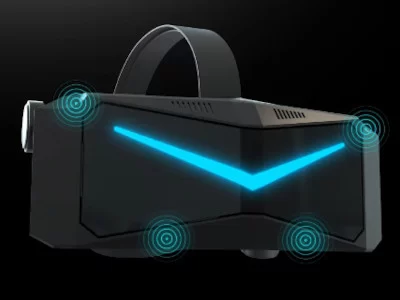The Pimax Crystal – set to release in Q3, 2022, delivers some of the most groundbreaking technology and lenses that I’ve seen. If it lives up to its hype, it could easily be the best premium-end “Quest 2 alternative” for consumers.
Here’s everything you need to know about the Pimax Crystal:
Pimax Crystal Specs
Summary of the specs:
- 5760 x 2880
- 42 ppd pixel density
- Modular lenses
- 120° FOV or (140° FOV with 35 ppd)
- Standalone with PCVR capabilities
- Inside-out tracking
- Tobii eye tracking
- Modular faceplating allows for outside-in tracking and color passthrough
- 60 Ghz PCVR wireless transmission
- Up to 160 Hz refresh rate
- XR2 Snapdragon processor
- Pimax Store
There’s no info about headset weight or binocular overlap %.
As someone who’s owned or tested most VR headsets, it’s difficult to say whether a headset is good or not just by looking at the specs. The specs only tell part of the story.
A large part of it comes down to the lenses and optics, but it definitely seems promising. I’ll provide an opinion and more in-depth review once I get to try it.
Pimax Crystal Lenses:
Most VR headsets come with polycarbonate (plastic) lenses, but the Pimax Crystal comes with glass lenses. This brings several advantages:
1. Higher Light Passthrough
Poly lenses tend to only allow 85-90% of the light to pass through, whilst crystal lenses allow 99% light passthrough. This makes the colors more vibrant.
The screen adopts QLED and Mini-LED technology that also allows it to achieve black levels similar to OLEDs.
2. Lower Aberation
Whenever light hits a surface (the lens), it will bend and cause distortion.
Since the Crystal’s lenses are made of glass, they can be made thinner with the same magnification as plastic lenses. This will result in much less aberation and distortion.
3. Lens Coating
The Crystal lenses come with 3 coatings:
- Blue light lens coating removes most blue light which has been shown to cause dry eyes, eye disease, disrupt sleep and a whole load of other things.
- Dust coating prevents dust buildup on the lenses
- And most importantly: anti-reflective coating removes most reflections (god rays) which plague other headsets.
Resolution and FOV
- 5760 x 2880
- 120° FOV
- QLED
The Pimax Crystal’s resolution has the same number of pixels as the Pimax 8K X, but with it’s lower field of view and smaller lenses, the pixels are less spread apart and this results in a much higher pixel density.
Pixel Density:
- 42 ppd
- 35 ppd (customized)
As a frame of reference, the Quest 2‘s pixel density is 21 ppd.
The Pimax Crystal offers up to 42 ppd which is the highest amongst consumer headsets. The human vision ppd is up to 60, whilst a ppd of 30+ is required to eliminate screen door effect.
Lens Customization
The Pimax Crystal offers lens modules which allows the user to customize visuals to tailor to their personal preference.
What that means is:
If you prefer a higher FOV, there’s an additional lens module that provides 140° FOV with a lower pixel density (35 ppd).
This is a very unique and cool feature not seen in any other headset.
Refresh Rate
Up to 160 Hz refresh rate.
Wireless and Standalone Capabilities
Two of the biggest causes of friction for VR are:
- Requiring a VR-capable PC
- Setting up external sensors (basestations)
The Pimax Crystal doesn’t require any of these, but gives the option to use them for hardcore VR enthusiasts.
Crystal WiGig is also a separate (optional) module that provides wireless transmission of PC data at 60 Ghz frequency, allowing users a way to access PCVR content wirelessly. They claim there’s almost zero frame drops if you’re within 3-5 meters from your PC.
Tracking
The Pimax Crystal uses inside-out tracking with 4 in-built cameras. Replaceable faceplates also allow option outside-in tracking.
Tobii Eye Tracking is also integrated into the headset. This allows for automatic IPD adjustments, reducing setup time and friction. The IPD range is stated to be 58-72mm.
Replaceable Faceplates
Another modular component of the headset is it’s replaceable faceplates (the front of the HMD).
There’s currently 2 custom faceplates (at an additional cost):
- Steam Lighthouse Tracking faceplate – to allow accurate outside-in tracking and full-body tracking
- Color passthrough faceplate for mixed reality.
Hardware Requirements:
- Full resolution mode: RTX 20 series graphics card (Turing) or AMD Radeon 5000 (Navi)
- Minimum specs: GTX 1070 or AMD Radeon 480
Other Features:
- 6000 mAh battery at the rear strap to provide a balanced weight distribution
- Qualcomm XR2 Snapdragon chip
- DMAS audio strap
Release Date and Price
Price: $1899 (Comes with DMAS audio strap and 2 controllers, a 35 ppd lens set, cable, 6000 mAh battery)
Previous Pimax owners get a $100 discount and another $100 off the Lighthouse faceplate.
The exact date hasn’t been specified yet, but the product will be shipped out during Q3 2022.
Discounts on Other Pimax Headsets
As a result of this release, for the first week of June, other Pimax headsets are discounted:
Source
